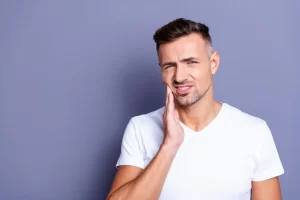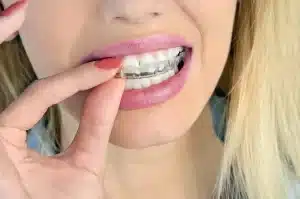What are the consequences of teeth clenching and/or grinding?
Table of Contents
Toggle-
What is teeth clenching/grinding?
Teeth clenching and/or grinding, otherwise known as bruxism, has had many technical definitions over the years. The currently accepted definition defines bruxism as a repetitive jaw-muscle activity characterized by clenching or grinding of the teeth and/or by bracing or thrusting of the mandible (lower jaw).
It is important to think of these behaviours as normal unless there are deleterious consequences (see further section). Everyone to some degree will clench and/or grind their teeth at some point in their lives. What is important to realise is that bruxism can be a symptom of an underlying disorder. It can occur either during sleep (nocturnal) or wakefulness (awake) and in some cases may be protective.
Approximately 20% of the adult population experience awake clenching. 8% of adults are aware of grinding their teeth during sleep. Rhythmic masticatory muscle activity during sleep occurs in 60% of ‘normal’ sleepers.

-
Understanding clenching/grinding
-
Causes
-
The aetiology (cause) of bruxism is multifactorial and often there are multiple factors involved. Importantly, teeth clenching/grinding signifies there is an underlying cause, which may or may not require investigation, and bruxism is simply the sign or symptom.
Pathophysiological causes of bruxism include respiratory disturbances and sleep arousals such as those seen in sleep-disordered breathing/ sleep apnoea where there is central (autonomic) nervous system dysfunction. Movement disorders, including those associated with sleep, are also other possible explanations for bruxism in this context given the influence of the central nervous system on neurotransmitter levels and function. The other factor worth considering in this domain is that bruxism may occur alongside with acid reflux or GORD. Exogenous factors such as medications, drugs, smoking, alcohol, and caffeine are also related in this context.
Psychosocial causes of bruxism are related to stress, anxiety/PTSD along with certain personality traits such as a tendency for perfectionism. Unfortunately, many of these factors also negatively influence sleep which might partly explain why bruxism may be seen nocturnally in these settings.
Occlusal (bite) factors have been shown in the literature to not be a cause of bruxism although this was the leading theory several years ago and multiple patients were subjected to, likely unnecessary, treatment including full mouth rehabilitations. A word of caution should be made here in that sometimes a person’s envelop of function is not in harmony with the anterior guidance. As a result, teeth, notably front (anterior), may chip and be prone to wear. This is not related to bruxism per se but does highlight that restorative intervention is indicated.
Nutrition may also play a role with as those with certain micronutrient deficiencies e.g. iron, may be more at risk of bruxism and other movement disorders. Genetics has also been implicated but no specific genes have been identified that place an individual at increased risk of bruxism. Environmental factors are more likely to be the underlying cause.

-
Short-term effects and long-term consequences
Bruxism is a masticatory muscle behaviour NOT necessarily a disorder – it can have good and bad consequences. There is some evidence that bruxism may in fact be protective particularly in the setting of respiratory/sleep disturbances and acid reflux. In these scenarios bruxism may aid in increasing upper airway muscle tone (to maintain a patent airway and prevent it from collapsing) and stimulating saliva flow (neutralising acids from reflux) respectively.
If bruxism is physiological i.e. a behaviour, it does not need treatment. The underlying cause may still require further investigation. When bruxism becomes pathological there are several negative consequences, and these will require management as well as exploring the reason(s) behind bruxism.
In the short-term, bruxism may result in fracture of teeth and/or restorations and contribute to the development of crack propagation in teeth and dental materials. This might result in toothache and an emergency visit to the dentist. During an acute period, bruxism may be partly responsible for headaches, migraines, jaw joint and neck/shoulder tension and pain. Bruxism can also injure the soft tissues of the mouth and compromise the periodontal (gum) support of the teeth.
Over time, damage to teeth and gums may negatively affect mastication (chewing), deglutition (swallowing) and speech (phonation). This might require extensive dental treatment including orthodontics, surgery, and rehabilitation in severe cases. Bruxism can result in chronic pain and/or dysfunction; this depends on the adaptive capacity and resilience of the masticatory system and is not equal in all individuals.
Bruxism in children deserves special attention. When signs or symptoms of bruxism are seen in the paediatric population as a result of respiratory disturbances/sleep arousals, this has the potential to negatively influence cranio-facial growth and development along with neurocognitive impairment. The consequences may range from dental crowding all the way to poor academic performance. Despite its high prevalence in children, screening for bruxism is extremely important and any sign(s) of airway dysfunction require prompt investigation.
Overall, it makes sense to take a pro-active approach and PREVENT these problems. This is why it is important to attend periodic oral examinations to detect signs of bruxism in its early stages or report any concerns to your dental practitioner.
-
Diagnosis and evaluation
When it comes to diagnosis of bruxism there are three distinct methods that have been identified in the literature. A possible diagnosis of bruxism exists when an individual reports this behaviour. A probable diagnosis of bruxism occurs when there are clinical signs of the disorder (see above section). A definite diagnosis of bruxism can only be made by a diagnostic sleep study or EMG analysis.
When there are concerns about sleep, particularly when a sleep-related breathing disorder is suspected a diagnostic sleep test is indicated. Sleep bruxism can be a symptom of an underlying sleep disorder. Practitioners in the field of dental sleep medicine are trained to specifically look for the signs of bruxism as they often relate to a sleep-related breathing disorder.
When looking for clinical signs of bruxism, the following may be seen (not an exhaustive list):
- Masticatory muscle enlargement,
- Oro-facial pain e.g. headaches, neck, jaw joint pain
- Tooth wear and cracks,
- Tooth/restoration/implant fractures and breakages,
- Soft tissue damage (tongue and inside of the cheek).
Tooth wear deserves a special mention but is generally an unreliable guide to bruxing activity. The reason being is that tooth wear has a multifactorial aetiology, often with erosion as the underlying and overriding cause. This can be as a result of extrinsic factors e.g. diet or intrinsic factors i.e. acid reflux/GORD. This is diagnosed by a medical practitioner however dental practitioners are sometimes the first clinicians to suspect this. When reflux occurs in combination with bruxism the consequences on the dental hard and soft tissues can be disastrous.
-
Treatment options
As stated previously, bruxism itself requires no treatment. The underlying cause should be investigated, particularly if there are other risk factors suggestive of respiratory and/or sleep disturbances. Treatment of the consequences of bruxism are indicated when it is deemed to be a disorder or pathological.
From a dental perspective, restoration/replacement of teeth assists in function and may enhance overall dento-facial aesthetics.
From a sleep medicine perspective, the underlying cause of bruxism should be investigated and managed. This may entail a diagnostic sleep study and treatment with an oral appliance. The benefit of this treatment modality is that a sleep device treats the underlying cause for the bruxism i.e. sleep apnoea AND protects the teeth/restorations from further damage.
Psychosocial causes of bruxism may involve working with a psychologist including stress counselling and avoiding certain external triggers e.g. caffeine, alcohol/sedatives.

-
When to seek medical/dental advice?
An evaluation with a suitably qualified dental practitioner should take place if there are any concerns around clenching and/or grinding of your teeth. A review of your medical history along with a comprehensive evaluation will be required and potentially further investigations to elucidate the cause. If you have identified you are suffering from any of the many potential consequences of bruxism, then a review with your treating clinician is warranted.
Book an appointment at one of our many locations across Queensland today. Remember that addressing issues early can significantly enhance your quality of life and long-term health.
Written by QLD Dental Sleep Therapy dentist, Dr Alex McDonald
Reference List
- Lavigne GJ, Rompre PH, Poirier G, Huard H, Kato T, Montplaisir JY. Rhythmic masticatory muscle activity during sleep in humans. J Dent Res. 2001 Feb; 80(2): 443-8
- Lobbezoo F, Ahlberg J, Raphael KG et al. International consensus on the assessment of bruxism: Report of a work in progress. J Oral Rehabil. 2018; 45(11): 837-844




